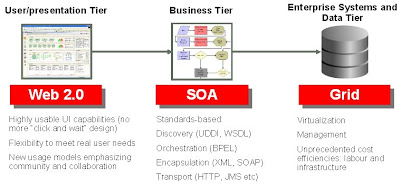Oracle Virtual Directory (OVD) is one of the little-known or understood
hero products in the Oracle suite of technology offerings [I put OEM Grid Control in the same class].
In this post I'm going to share a few thoughts on OVD, and present a few approaches for using OVD to present a restricted view of information from another directory, and how that can be used to limit access to applications that use an LDAP authentication mechanism.
When I was first learning about OVD back in early 2007, after the Oracle acquisition, it immediately grabbed my attention. Simple, easy to use, but so powerful - a swiss army knife for anyone working in the directory management space. Maybe that is the wrong analogy, because the greatness in OVD is that it doesn't try to boil the ocean - it just does one thing, but does it really well.
Simply put, it allows you to combine directory-related information from disparate sources (LDAP, AD, database etc) and present an LDAP-compliant view in real-time. And the
virtual bit is
real (if that makes any sense) - OVD doesn't store anything, unlike a meta-directory; it just passes through the directory requests according to the rules you setup.

The virtual nature makes OVD ideal in large enterprise situations, where control of directories may be distributed. Another group may have a directory that contains some information you want to use as part of your "directory view", but are not going to cede any ownership or agree to any changes anytime soon, like adding some new attributes. Wheel in OVD!
Likewise, affiliated companies may want to share directory information, but not handover control. And if the business relationship comes to and end, the directory owners want to know that they can turn off access in a moment, without needing worry about cached or replicated data left on the other side of the corporate divide. OVD to the rescue!
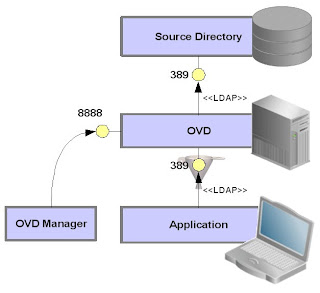
Case in Point: you need a subset of an existing directory
The inspiration for this post is a small challenge I was involved with recently. The company was deploying a new web application - just happened to be Oracle WebCenter Wiki, but the same applies to any application that supports LDAP authentication.
The only directory available contained a mix of users - some who should be able to access the wiki, and some who shouldn't. Configuring the wiki authentication mechanism at the directory is simple - but it is an all or nothing proposition. And of course, we couldn't go change anything the directory itself.
Sounded like a job for OVD!
Here's the basic setup - OVD is deployed between our application and the main directory, like a proxy server. We want to OVD to effectively "filter" requests from the application.
Configuration of OVD is done using the OVD Manager client, which connects to the administration port of the OVD server.
Approach #1: DN Matching
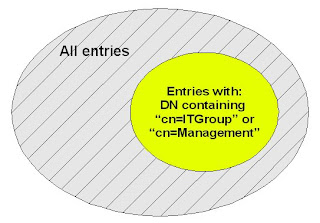
If you can define the distinction between included/excluded entries in terms of an entry's DN, then a very simple solution is to use the "DN Matching" property of the source adapter. This is fund in the
Routing configuration.
Say for example, we only wanted our OVD directory to include entries that are in the ou=ITGroup or ou=Management containers. In this case, we would set the DN Matching property with a regular expression that will match on the DN string:
m/(.*)ou=(ITGroup|Management)(.*)/

Approach #2: ACL Restrictions
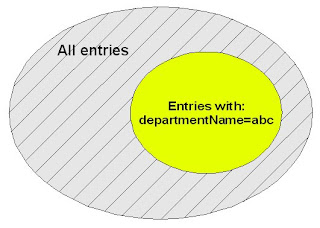
In practice, the DN may not provide enough information to distinguish items to include and exclude, and it is necessary to discriminate on the basis of an attribute, such as "departmentName". In this case, access control in the OVD engine may be configured to restrict the directory view based on a suitable filter.
Filter: departmentName=ITGroup
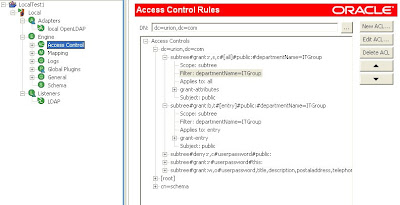
It is important to note with this approach that ACLs can be applied to all LDAP operations, except bind.
As a result, the directory view we have created with OVD appears to only contain the filtered subset of information: we cannot browse, serach, get or modify anything else. However, if you present a fully-qualified DN and associated password,
it will authenticate and bind any entry that exists in the source database.
On spec, that seems to blow the whole approach out of the water. That's what I was thinking too, until
Mark Wilcox helpfully nudged me along with a neat insight...
If our requirement is to use OVD to restrict the set of users that can authenticate via an application, we only need to consider the application authentication mechanism. In most cases, the process is similar to the one illustrated below. The user enters an id or username, which is used by the application to lookup the user's DN, which is then used to bind along with the user-supplied password. If the application can't find the DN in the first place, then no bind is possible.
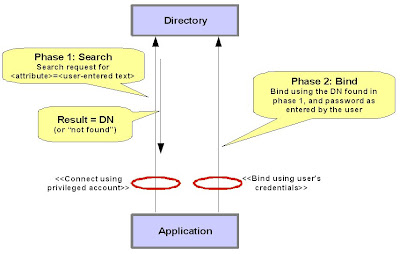
Of course, the acknowledged security "exposure" in this case is that a user can bypass the application and directly bind via OVD if they know their DN. However this is probably a false risk, because the user would have always had a similar capability with the source directory itself
(assuming that the source directory and OVD are equally accessible to the user over the network).
Bottom line? Using ACLs to restrict the search effectively controls the set of users that the application can authenticate.In Practice: Oracle WebCenter Wiki
Oracle WebCenter Wiki is thye example application, but you can think of it as any old J2EE application packaged as an EAR that supports Java SSO. By default it will use JAZN XML file-based storage for user accounts.
When deployed in OC4J, the security provider used for the Wiki application can be easily changed via the Enterprise Manager web interface.
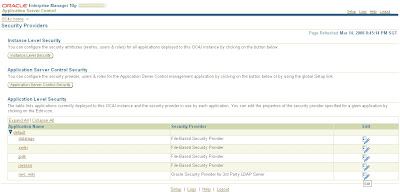
Switching to OVD as the authentication source is a simple matter of selecting the
Oracle Security Provider for 3rd Party LDAP Server and configuring it with some simple directory details:
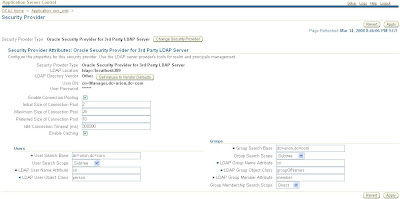
Almost done. There are two assumptions that I think the wiki makes about the directory. Just need to make sure these are setup:
- wiki users must be members of the group called "users"
- administrators are members of the group called "oc4j-administrators"
Now you are done. The wiki authentication is being performed against the limited set of users visible through OVD.
Caveat: selecting the
Oracle Security Provider for 3rd Party LDAP Server causes the site to revert to basic authentication (i.e. popup a username/password dialog instead of using a web form). Not a big deal, but you will find the "logout" feature in the wiki now fails because it assumes form-based custom authentication. So once you have people lured into your wiki, they are trapped! ;-)
Wrapping Up
I've covered two techniques for restricting the set of information published via OVD:
DN Mapping, and
ACL Filters.
There are other approaches that I've not covered here. For one, Java or Python plug-ins (a.k.a. mappings) can achieve the same result, as well as more complex behaviours of course.
These techniques allow OVD to be used to restrict overall access control for applications that use LDAP authentication mechanisms.
Once again, hat-tip to Mark Wilcox for his help when I thought I'd hit a wall while researching this topic!

 What else? Well, I'm surprised they persist in using the special 2-prong audio jack. I'm sure there's some weird logic about discouraging passengers from nicking the headsets (even though policing headset issue and collection still seems to rate as one of the cabin staffs' most important duties!)
What else? Well, I'm surprised they persist in using the special 2-prong audio jack. I'm sure there's some weird logic about discouraging passengers from nicking the headsets (even though policing headset issue and collection still seems to rate as one of the cabin staffs' most important duties!) 
























